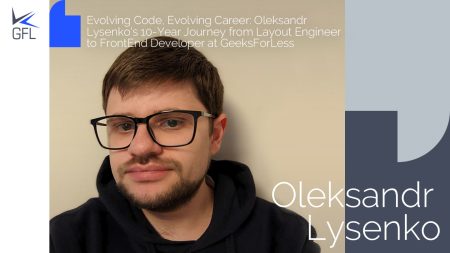Unveiling the World of VR/AR/MR Development with GeeksForLess
Dive into the World of VR/AR/MR Development with GeeksForLess
At GeeksForLess, we’re thrilled to share a series of interviews that delve into the immersive universe of Virtual Reality (VR), Augmented Reality (AR), and Mixed Reality (MR) technology. Get ready to embark on a journey where we demystify these technologies, explore their applications, and gain insights into the fascinating world of VR/AR/MR development.
Let’s delve into the exciting realm of VR/AR/MR technology. Could you begin by elucidating the distinctions between Virtual Reality (VR), Augmented Reality (AR), Mixed Reality (MR), and Extended Reality (XR)?
GeeksForLess: Certainly! Virtual Reality (VR) completely immerses users in a digitally simulated environment, replacing the physical world. Augmented Reality (AR) overlays digital elements onto the real world, enhancing users’ perceptions of their surroundings. Mixed Reality (MR) bridges the gap by integrating digital content into the physical world, allowing interaction between the two. Extended Reality (XR) serves as an umbrella term encompassing VR, AR, and MR, aiming to create seamless transitions between real and virtual environments.
That clarifies the landscape. Can you provide examples of popular VR, AR, or MR devices and applications?
GeeksForLess: Of course. VR boasts devices like the Oculus Quest 2 and HTC Vive, widely employed in gaming and immersive experiences. AR thrives through smartphones equipped with ARKit or ARCore, as well as smart glasses like Google Glass, used for augmented reality experiences. MR technology shines in the form of Microsoft’s HoloLens, which empowers users to interact with virtual objects within their real environment. These technologies find applications across diverse domains, from gaming and training to navigation, education, and interactive marketing.
Languages, Frameworks, and User Interface Design
Excellent examples. Now, in the realm of VR/AR/MR development, what programming languages and frameworks are commonly embraced?
GeeksForLess: In VR/AR/MR development, the choice of programming languages and frameworks hinges on the target platform and specific technology. Unity3D is a prominent game engine, utilizing C# for scripting and providing robust support for various VR and AR platforms, such as Oculus, HTC Vive, and HoloLens. Unreal Engine, predominantly driven by C++, is celebrated for its high-quality graphics and is often the go-to choice for VR development. For mobile AR, ARKit and ARCore serve as essential software development kits (SDKs), complemented by Swift and Kotlin for Android development. Vuforia, a versatile AR development platform, accommodates languages like C#, Java, and Swift. The selection primarily depends on project requisites and developers’ familiarity with the tools. For instance, C# in combination with Unity is a prevalent choice among VR and AR developers.
Thank you for the very clear overview. When it comes to designing user interfaces for immersive experiences in VR/AR/MR, what approach do you typically adopt?
GeeksForLess: Designing user interfaces for VR/AR/MR necessitates a thoughtful strategy. We initiate by thoroughly comprehending the technology’s capabilities and limitations. Subsequently, our focus revolves around meeting user needs while preserving simplicity. We place interface elements logically within the 3D space, align them with platform interaction paradigms, and strive for familiarity and predictability. Continuous testing, iteration, and the collection of user feedback form integral components of our design process. This holistic approach is dedicated to ensuring a seamless and intuitive user experience that resonates with our audience.
That’s indeed a comprehensive approach. To ensure a smooth and intuitive user experience in VR/AR applications, what steps do you take?
Interviewee: A smooth and intuitive user experience is a paramount concern for us. To achieve this:
- We prioritize a clean and straightforward interface design, avoiding clutter and complexity.
- Our actions and interactions are designed to feel natural and intuitive, aligning with real-world expectations.
- We actively gather feedback from real users, facilitating iterative improvements to enhance the user experience continually.
- Performance optimization is a critical aspect of our approach, ensuring a comfortable and responsive experience by minimizing lag or delays.
- Accessibility is always at the forefront of our considerations, accommodating various user needs through features like voice commands, screen readers, and text-to-speech.
- We endeavor to seamlessly integrate interface elements into the virtual or augmented world, avoiding any jarring transitions or disconnections.
- By adhering to these principles, we aim to create immersive experiences that not only captivate users but also provide an enjoyable and intuitive journey.
Pushing Boundaries: Innovative Interaction Design
Excellent strategies for enhancing the user experience! Moving on, can you share some examples of innovative interaction design in VR and AR development?
GeeksForLess: Certainly! Innovative interaction design is at the forefront of enhancing the user experience in VR/AR. Here are some compelling examples:
- Hand Tracking in VR: VR headsets like the Oculus Quest 2 and devices like the Microsoft HoloLens 2 use hand tracking, allowing users to interact with virtual objects using natural hand gestures.
- Spatial Audio in AR: In AR, spatial audio provides a realistic sense of sound direction and distance, enhancing immersion. For example, Pokémon Go uses spatial audio to make creatures sound like they’re coming from specific locations.
- Gesture Recognition in AR: AR apps like Magic Leap use gesture recognition to enable users to control interfaces and interact with virtual objects through hand movements.
- Eye Tracking in VR: Some VR headsets, like the HTC Vive Pro Eye, incorporate eye tracking, which can be used for foveated rendering (reducing graphics load on peripheral vision) and more natural social interaction in VR.
- Haptic Feedback: Devices like the Oculus Touch controllers offer haptic feedback, providing tactile sensations when interacting with virtual objects. It enhances the sense of touch in VR.
- Voice Recognition: VR and AR apps often include voice recognition technology, allowing users to control interfaces and interact with objects through voice commands. For instance, Microsoft’s Cortana in HoloLens.
- Object Recognition in AR: AR apps like IKEA Place use object recognition to let users place virtual furniture in their real environment. The app identifies the shape and size of real furniture and adjusts the virtual object accordingly.
- Facial Tracking in AR: Snapchat and Instagram offer AR filters that track users’ facial movements and add virtual elements, such as masks and animations, in real-time.
- Spatial Computing in MR: Magic Leap employs spatial computing to understand and interact with the physical world, overlaying digital content seamlessly.
- Physics Simulations in VR: VR games and experiences often incorporate realistic physics simulations, allowing users to interact with objects in a lifelike manner.
These examples demonstrate how innovative interaction design in VR/AR enhances the user experience, creating more immersive and intuitive ways to engage with virtual and augmented environments.
We’ve delved into the captivating universe of Virtual Reality (VR), Augmented Reality (AR), and Mixed Reality (MR) in this insightful first part of our interview. GeeksForLess has provided us with a wealth of knowledge about these immersive technologies and the intricate world of development that brings them to life.
But the journey doesn’t end here! We invite you to stay tuned for part two of our interview, where we’ll venture further into the future of VR/AR/MR. In the next installment, we’ll explore emerging trends, GeeksForLess’s innovative strategies, and the limitless potential these technologies hold.
Whether you’re a seasoned developer, an enthusiast, or simply curious about the cutting-edge advancements in VR/AR/MR, there’s something in store for everyone. So, mark your calendars and join us for the next part of this exciting conversation. Together, we’ll continue to unlock the endless possibilities of immersive technology. See you in part two!











